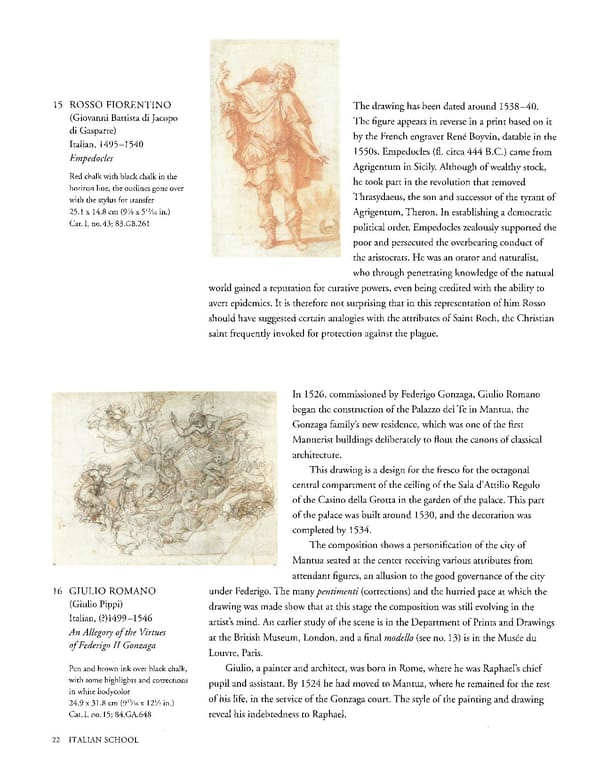15 ROSSO FIORENTINO The drawing has been dated around 153840. (Giovanni Battista di Jacopo The figure appears in reverse in a print based on it di Gasparre) by the French engraver Rene Boyvin, datable in the Italian, 14951540 Empedocles 1550s. Empedocles (fl. circa 444 B.C.) came from Agrigentum in Sicily. Although of wealthy stock, Red chalk with black chalk in the he took part in the revolution that removed horizon line, the outlines gone over with the stylus for transfer Thrasydaeus, the son and successor of the tyrant of 13 25.1 x 14.8 cm (9 x 5 /16 in.) Agrigentum, Theron. In establishing a democratic Cat. I, no.43; 83.GB.261 political order, Empedocles zealously supported the poor and persecuted the overbearing conduct of the aristocrats. He was an orator and naturalist, who through penetrating knowledge of the natural world gained a reputation for curative powers, even being credited with the ability to avert epidemics. It is therefore not surprising that in this representation of him Rosso should have suggested certain analogies with the attributes of Saint Roch, the Christian saint frequently invoked for protection against the plague. In 1526, commissioned by Federigo Gonzaga, Giulio Romano began the construction of the Palazzo del Te in Mantua, the Gonzaga family's new residence, which was one of the first Mannerist buildings deliberately to flout the canons of classical architecture. This drawing is a design for the fresco for the octagonal central compartment of the ceiling of the Sala d'Attilio Regolo of the Casino della Grotta in the garden of the palace. This part of the palace was built around 1530, and the decoration was completed by 1534. The composition shows a personification of the city of Mantua seated at the center receiving various attributes from attendant figures, an allusion to the good governance of the city 16 GIULIO ROMANO under Federigo. The many pentimenti (corrections) and the hurried pace at which the (Giulio Pippi) drawing was made show that at this stage the composition was still evolving in the Italian, (?) 14991546 artist's mind. An earlier study of the scene is in the Department of Prints and Drawings An Allegory of the Virtues at the British Museum, London, and a final modello (see no. 13) is in the Musee du of Federigo II Gonzaga Louvre, Paris. Pen and brown ink over black chalk, Giulio, a painter and architect, was born in Rome, where he was Raphael's chief with some highlights and corrections pupil and assistant. By 1524 he had moved to Mantua, where he remained for the rest in white bodycolor 24.9 x 31.8 cm (9 13/16 x I2½ in.) of his life, in the service of the Gonzaga court. The style of the painting and drawing Cat. I, no. 15; 84.GA.648 reveal his indebtedness to Raphael. 22 ITALIAN SCHOOL
 Masterpieces of the Getty Museum: Drawings Page 22 Page 24
Masterpieces of the Getty Museum: Drawings Page 22 Page 24